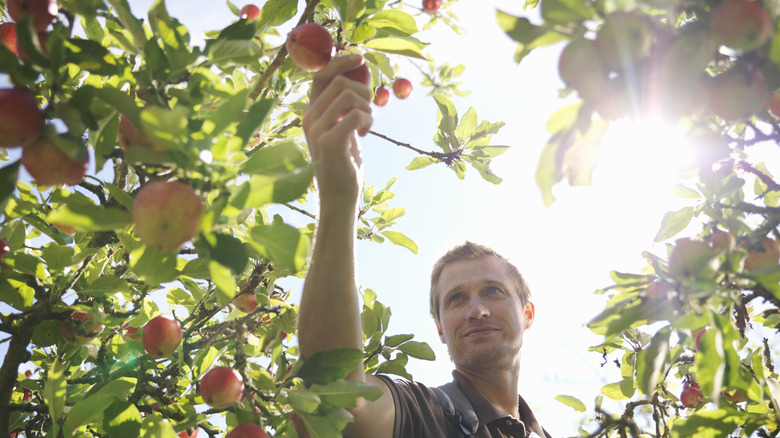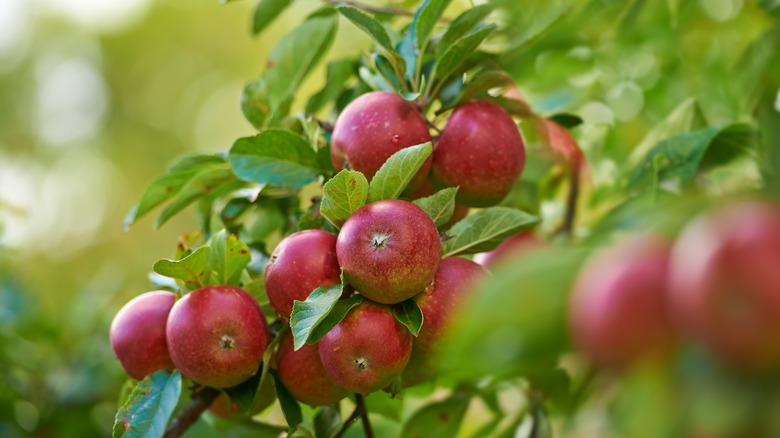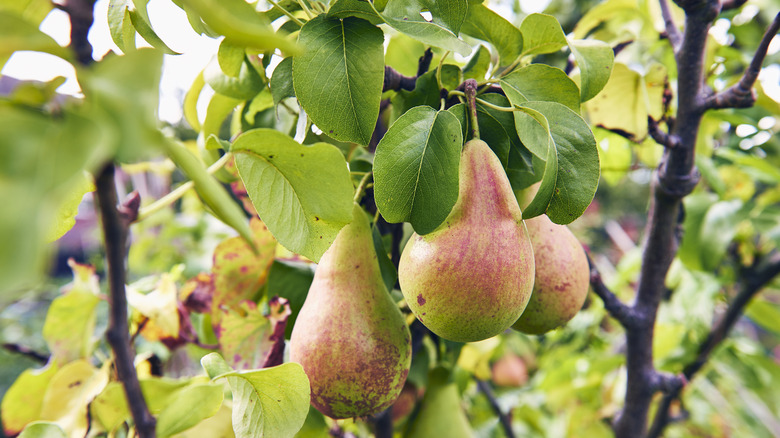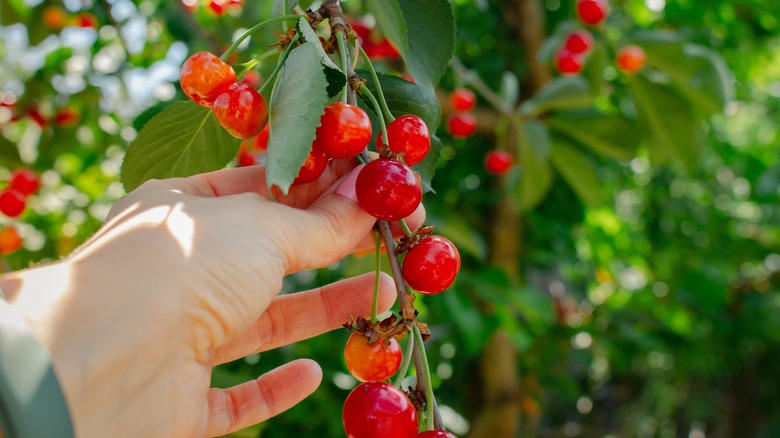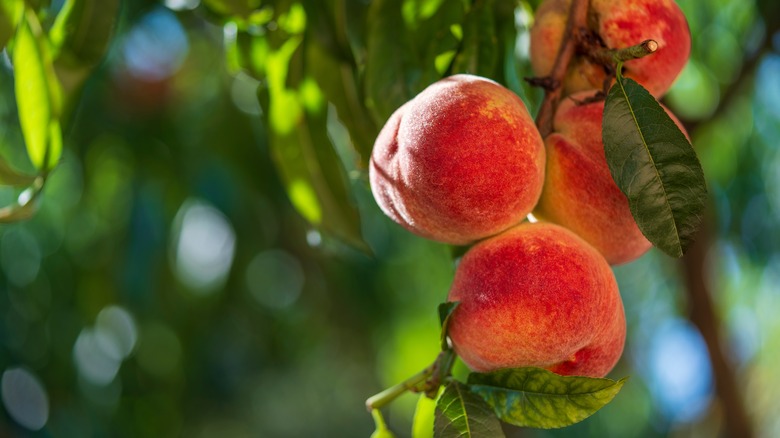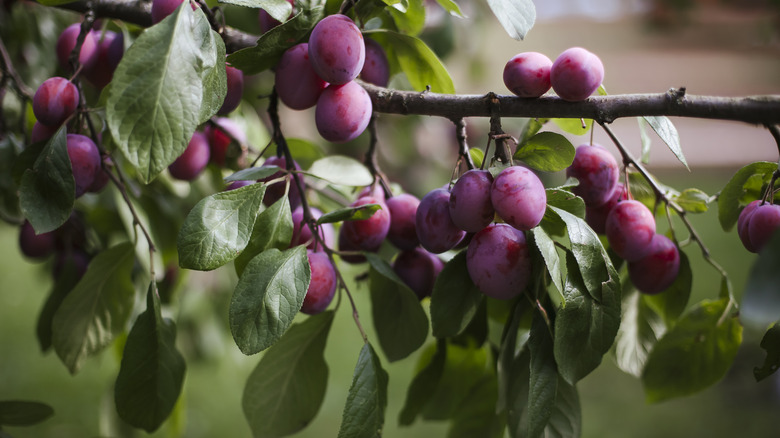How To Choose And Apply The Right Fertilizer To Your Fruit Trees
We may receive a commission on purchases made from links.
If you have an orchard full of fruit trees, you may rightly wonder how to keep them fed and happy enough to deliver abundant harvests each year. Depending on what species you're growing and what your soil conditions are like, your fruit trees may need little to no fertilizer at all. However, some trees are heavier feeders than others, and certain soil conditions may necessitate more nutrients to be added with fertilizer, either before planting or with regular, annual applications.
In most cases, nitrogen is the most crucial nutrient to be added via fertilization. That's because a lack of nitrogen can limit the growth of several fruit trees. However, phosphorus and potassium levels may also need to be corrected, depending on the trees you're growing and the contents of the soil in your orchard. Below, we take a closer look at the fertilizer needs of five commonly grown fruit trees — apples, pears, cherries, peaches, and plums. You'll learn how to choose the ideal food for each tree based on its nutritional needs, and we'll walk you through the best practices for applying the fertilizer effectively. Before applying any fertilizer, however, always read and follow the package instructions to ensure it's used correctly.
Apple trees could benefit from a balanced, 10-10-10 fertilizer
Of all the nutrients typically included in fertilizers, apple trees need nitrogen the most — in fact, they need fresh applications of it every year. Phosphorus and potassium are also essential when caring for an apple tree, especially when the trees are young (and less so after the trees reach maturity). Given the greater need for phosphorus and potassium at an early age, it's beneficial to add these nutrients to the soil before planting the fruit trees.
Here's how you'd do it: a month before you plant the trees in your yard, determine the exact location of the tree and measure a 2-foot-diameter circle with the future hole as the center. Then, broadcast one cup of 10-10-10 fertilizer (i.e., 10 parts nitrogen, phosphorus, and potassium, respectively) inside the 2-foot circle. After you've planted the tree, wait until early summer and treat the same 2-foot circle around the young tree with the same amount of 10-10-10 fertilizer. As the tree nears its first birthday the following year, apply another cup of 10-10-10 fertilizer, but this time, broadcast it over a 3-foot-diameter circle. Come June, repeat the process one more time.
As the tree matures, phosphorus and potassium become less vital. However, periodic soil testing (done at least once every two years) offers the best way to establish which nutrients should be present in the fertilizer you give the trees. Experts recommend using 10-6-4 fertilizer on apple trees one year and older. Starting with half a pound at the age of one, the fertilizer should be applied annually to the tree, with half-pound increases each year.
Pear trees typically need nitrogen the most
Like apples, pears also generally require nitrogen-heavy fertilizers the most, as a lack of nitrogen can be a major factor preventing healthy growth. A good way to tell whether or not your pear tree is getting enough nitrogen is to gauge how vigorously it grows. If you're observing at least 18 inches of new growth every year, the soil nitrogen levels are satisfactory. Otherwise, you can make annual applications of 10-10-10 fertilizer, giving the tree a cup of the food for every year of its age (although 12 cups is the maximum recommended quantity). Don't give the entire portion at once, though. Apply the first half before the tree starts growing in the spring and the other half after fruits appear. When applying the fertilizer, broadcast it evenly inside the dripline under the tree's canopy.
On some sites, the soil may be severely lacking in phosphorus. This is usually an issue with volcanic soils, as they tend to absorb the nutrient in greater quantities. To make sure that your pears will have enough phosphorus to thrive, you should test the soil before planting them. If the phosphorus test reads below 30 ppm, add a 0-45-0 fertilizer, like Garden-Rich's Triple Super Phosphate, to the hole. Then, throw some soil on top of the fertilizer before you plant the trees.
Cherry trees need 0.1 actual nitrogen per each year of life
If you've planted your cherries in rich soil, the only nutrient you'll have to add on a regular basis is nitrogen. How much nitrogen you give your cherries depends on their growth patterns. There's likely enough nitrogen in the soil if you observe the branches growing at least 10 inches or so every year. On the other hand, more stunted growth likely means a lack of the nutrient. Conversely, if the tree refuses to shed leaves well into the fall and remains stubbornly green, it could be due to elevated nitrogen levels in the soil. While assessing the exact nitrogen needs this way is challenging, a good rule of thumb is to give 0.1 pounds of actual nitrogen for each year of the tree's life annually (never more than 1 pound of actual nitrogen per year). If the tree grows in sod, you should supply a bit more of the nutrient to account for the sod's needs.
You can calculate how much fertilizer to apply to add nitrogen to your soil in sufficient quantities by checking the percentage stated on the product package. For example, if you're using this 46-0-0 urea fertilizer from The Grow Co., you'll know the compound contains 46% nitrogen. This means you'll need roughly 2.2 pounds of the substance to get 1 pound of actual nitrogen. To feed your cherries, broadcast the nitrogen fertilizer beneath the tree canopy, covering the area from the dripline to within a foot or so off the trunk.
Peach trees may need nitrogen fertilizer if exhibiting poor growth
If you're growing peach trees, you'll need to add a nitrogen-based fertilizer if the tree is exhibiting poor growth. How much fertilizer you need to give depends on the tree's age. If your peach tree is less than three years old and you're not seeing it grow by at least a foot, give it half a cup of nitrogen-heavy, 20-0-0 fertilizer. You should feed the tree early enough in the spring that it still has no leaves. Broadcast the nitrogen-heavy fertilizer around the tree's root zone and give it a good soaking so that the water soaks the nitrogen fertilizer into the soil. If you're not seeing more vigorous growth after the first application, repeat the same steps at the end of spring (but never as late as July).
For older peach trees, your benchmark growth should be about 12 inches per year. If the tree falls short of this mark, feed it the same 20-0-0 fertilizer, but increase the quantity to 2 cups. A single application early in the season should do. Trees that exceed the growth benchmarks mentioned above don't need fertilizer that year.
Meanwhile, phosphorus and potassium should only be added if the soil tests reveal a severe lack of these nutrients in the growing medium. You should perform these soil tests at least every three years or so. If the tests show insufficient quantities of these nutrients in the growing medium, feed the tree a cup of 16-16-16 fertilizer once a year until the soil tests show an improvement in the nutrient content.
Plum trees may not need fertilizer at all
Plum trees have very limited fertilizer needs. In most cases, you only need to feed plum trees if they're not growing vigorously enough, and you've established that a lack of nutrients is the culprit. Generally, plum trees should grow about 15 inches per year when young and 8 inches after they mature. If your plum trees are having trouble meeting these growth benchmarks, you should rule out other possible root causes, including pests, inadequate irrigation, and disease. Alternatively, run a soil test to check for nutrient deficiency. If it seems likely that a nutritional deficiency is behind the lack of vigor, nitrogen is likely the nutrient that needs a boost. A 20-0-0 fertilizer can be given to correct a nitrogen deficiency; give about 1 cup to plum trees that are in their first five years of life and 2 cups for older trees.
There are a few best practices surrounding plum tree fertilization. For one, you shouldn't feed young plum trees that have just been planted. Likewise, if you need to correct a phosphorus deficiency in the soil, do so by adding phosphorus to the soil a year before planting the plums. Finally, when applying fertilizer, broadcast it right underneath the trees' dripline.
